Fifth of July Mountain facts for kids
Quick facts for kids Fifth of July Mountain |
|
|---|---|

Northwest aspect, from Carne Mountain
|
|
| Highest point | |
| Elevation | 7,696 ft (2,346 m) |
| Prominence | 1,256 ft (383 m) |
| Isolation | 3.81 mi (6.13 km) |
| Parent peak | Chilly Peak (7,960 ft) |
| Geography | |
| Location | Glacier Peak Wilderness Chelan County, Washington, U.S. |
| Parent range | Entiat Mountains North Cascades Cascade Range |
| Topo map | USGS Saska Peak |
| Climbing | |
| Easiest route | class 2 hiking |
Fifth of July Mountain is a tall mountain in Washington state. It stands 7,696 ft (2,350 m) high! This mountain is part of the Entiat Mountains, which are a smaller range within the larger North Cascades. You can find it in Chelan County.
The mountain is located inside the Glacier Peak Wilderness. This is a special protected area managed by the Okanogan-Wenatchee National Forest. The closest taller mountain is Chilly Peak, about 3.8 miles (6.1 km) to the north. Carne Mountain is also nearby, about 4 miles (6.4 km) to the northwest.
Water from the mountain flows in two directions. To the west, it goes into Rock Creek, which then joins the Chiwawa River. To the east, it flows into Cow Creek, which is part of the Entiat River. A surveyor named Albert Hale Sylvester gave the mountain its unique name. He named it after the day he visited it.
Contents
Mountain Weather: What to Expect
Fifth of July Mountain is located on the eastern side of the Cascade Range. This means it gets a bit less rain and snow compared to areas on the western side.
Summers here can be warm, and sometimes you might even see thunderstorms. Most of the weather systems start over the Pacific Ocean. They then travel northeast towards the Cascade Mountains.
How Mountains Affect Weather
When these weather systems reach the North Cascades, the tall peaks force the air to rise. As the air goes higher, it cools down and drops its moisture. This process is called Orographic lift. It causes a lot of rain or snow to fall on the mountains, especially in winter.
Because of its height, Fifth of July Mountain can have snow on its slopes in late spring and early fall. Winters on the mountain can be very cold.
How Fifth of July Mountain Was Formed
The North Cascades area has some of the most rugged and dramatic landscapes. You can see sharp peaks, long ridges, and deep valleys carved by glaciers. These amazing shapes were created by geological events that happened millions of years ago.
Ancient Earth Movements
The history of the Cascade Mountains began millions of years ago, during a time called the late Eocene Epoch. At that time, the North American Plate was slowly moving over the Pacific Plate. This movement caused many volcanic eruptions and created new rock.
For example, Glacier Peak is a large stratovolcano (a cone-shaped volcano). It started forming in the middle of the Pleistocene period. This volcano is about 17.8 mi (28.6 km) west-northwest of Fifth of July Mountain.
The Power of Glaciers
During the Pleistocene period, which was over two million years ago, huge sheets of ice called glaciers repeatedly moved across the land. As they advanced and retreated, they scraped and shaped the landscape. They left behind piles of rock and debris.
The "U"-shaped valleys you see in river areas are a direct result of these ancient glaciers. The combination of land being pushed up (called uplift) and cracks in the Earth's crust (called faulting), along with the power of glaciers, created the tall peaks and deep valleys we see in the North Cascades today.



